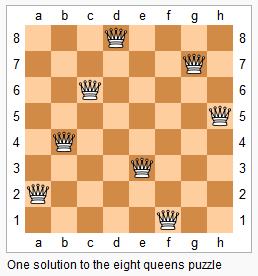52. N-Queens II (Hard)
https://leetcode.com/problems/n-queens-ii/
The n-queens puzzle is the problem of placing n queens on an n×n chessboard such that no two queens attack each other.

Given an integer n, return the number of distinct solutions to the n-queens puzzle.
Example:
Input: 4 Output: 2 Explanation: There are two distinct solutions to the 4-queens puzzle as shown below. [ [".Q..", // Solution 1 "...Q", "Q...", "..Q."], ["..Q.", // Solution 2 "Q...", "...Q", ".Q.."] ]
Solutions
class Solution {
private Map<String, Boolean> validityMap = new HashMap<>();
int ans = 0;
public int totalNQueens(int n) {
if (n < 1) {
return ans;
}
int[] queens = new int[n];
recurse(queens, 0);
return ans;
}
private void recurse(int[] queens, int col) {
if (col == queens.length) {
ans++;
return;
}
for (int row = 0; row < queens.length; ++row) {
for (int j = col + 1; j < queens.length; j++) {
queens[j] = -1;
}
queens[col] = row;
String key = Arrays.toString(queens);
// We use validityMap to keep the track of valid and invalid sequence so that
// we are able to reduce the computation overhead dramatically.
if (!validityMap.containsKey(key)) {
validityMap.put(key, isValid(queens, col, row));
}
// valid sequence, keep on digging into it.
if (validityMap.get(key)) {
recurse(queens, col + 1);
}
}
}
private boolean isValid(int[] queens, int col, int row) {
// col is the last index, not the length
for (int i = 0; i < col; ++i) {
// previous point (i, queens[i])
// horizontal comparision, check out if any pieces situated on same row
if (queens[i] == row) {
return false;
}
// Assume point A(a1, a2) and B(b1, b2) are diagonally arranged, abs(a1 - b1) == abs(a2 - b2).
// We can imagine that with point A and B as the diagonal points, we can form a square.
// As a square, all the edges should be of same length.
// diagonal comparision
if (Math.abs(col - i) == Math.abs(row - queens[i])) {
return false;
}
}
return true;
}
}